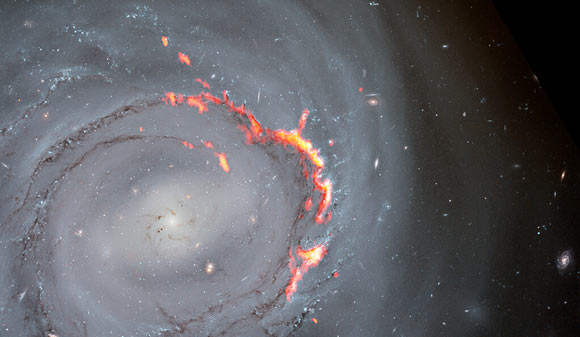Using data from the Atacama Large Millimeter Array (ALMA), the Combined Array for Research in Millimeter-Wave Astronomy (CARMA) and the NASA/ESA Hubble Space Telescope, astronomers have observed a cosmic boomerang effect — molecular gas streams that are stripped away from a galaxy only to circle back and return later — in the northwest quadrant of NGC 4921, a spiral galaxy in the Coma cluster. The observation offers new insights into the life cycle of galaxies and the structural formations within galaxies, as traced by molecular gas.

Zoomed in view of an ALMA (red/orange) and Hubble (optical) composite of NGC 4921; it highlights filament structures resulting from the effects of ram-pressure stripping. Image credit: ALMA / ESO / NAOJ / NRAO / S. Dagnello, NRAO / NASA / ESA / Hubble / K. Cook, LLNL / L. Shatz.
The Coma cluster is a large group of galaxies approximately 330 million light-years away in the northern constellation of Coma Berenices.
Also known as Abell 1656, the cluster is a great environment to study the ram-pressure stripping — a process known to strip gas out of galaxies, leaving them without the material needed to form new stars — at high resolution.
An excellent member of the cluster to study the effects of this process on the dense interstellar medium is NGC 4921, a massive, nearly face-on spiral galaxy.
“Astronomers are interested in studying how galaxies grow, live, and die,” said Dr. William Cramer, a postdoctoral researcher at Arizona State University.
“Effects like ram pressure that can speed up the normal galaxy lifecycle are very important to understand for this reason.”
“Furthermore, the molecular gas in galaxies is the birthplace of new stars, and therefore studying the effect of ram pressure on it is of paramount importance.”
Using data gathered by ALMA, Dr. Cramer and colleagues created a high-resolution map of dense molecular gas in NGC 4921.
The map shows unusual structures that form in the ram pressure ‘wind’ — long filaments of heavy gas connected to newly-forming stars.
This dense, heavy gas is thought to be more resistant to ram-pressure stripping, perhaps due to magnetic fields holding it more firmly in place.
“When an external force like ram pressure disturbs a galaxy, it offers an opportunity to learn about the internal forces that operate in galaxies,” said Professor Jeffrey Kenney, a researcher at Yale University.
“The unusual filaments would not form without magnetic fields, so we also learn about the importance of magnetic fields in galaxies from this ram pressure interaction.”
The ALMA data clearly show filaments of molecular gas connected to NGC 4921 — the filaments are, indeed, resisting.
But then the astronomer spotted something else — some of the previously-stripped gas comes back.
“Instead of being thrown out never to return, some of this gas is moving like a boomerang, being ejected but then circling and falling back to its source. If this gas is recaptured into the galaxy, it can form new stars,” Dr. Cramer said.
“The boomerang effect is significant for several reasons. It provides hard evidence about the evolution of galaxies.”
“It confirms a long-held theory about galaxy development; and it aids astronomers trying to predict the birthrate of new stars.”
“The interstellar medium of galaxies is complex, with many variables that are hard to model.”
“This observation is important because it shows that fallback of gas can be detected and allows us to search more broadly to help characterize it.”
The study will be published in the Astrophysical Journal.
_____
William J. Cramer et al. 2021. Molecular gas filaments and fallback in the ram pressure stripped Coma spiral NGC 4921. ApJ, in press; arXiv: 2107.11731







